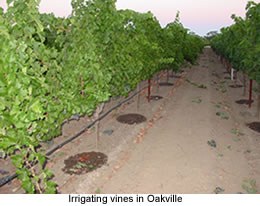
Irrigating vines in Oakville
a) Towards a better understanding of soil moisture deficits on shoot and root physiology
Eissenstat, DM, Neilsen D, Neilsen G.
Pennsylvania State University and Pacific Agri-Food Research Centre, Summerland, BC.
April 1, 2002-March 31, 2005. Funded by Washington Tree Fruit Research Commission and matching funds from AAFC-MII.
Studies are examining the effects of different irrigation practices on apple tree physiology in Summerland, British Columbia. The effects of deficit irrigation and partial root zone drying on root dynamics and shoot physiology will be examined over three years. The feasibility of using novel irrigation practices to reduce total irrigation, reduce vegetative growth and improve fruit quality will be assessed. This research will link root growth and mortality to apple water uptake, shoot water potential and leaf stomatal conductance and photosynthesis.
b) Seasonal patterns of root physiology and dynamics of Vitis vinifera cv Merlot on two rootstocks under different levels of irrigation.
Smart DR, Eissenstat DM, Bauerle TL.
Pennsylvania State University and University of California, Davis
Funded by Western Viticulture Consortium, July 1, 2002 - June 30, 2006
The long-term goals of the work are to: (a) develop our understanding of the relationships of grape root development and structure to root function (water and nutrient uptake, storage of carbohydrates and nutrients), to the environment (soil temperature, water, nutrients); to root pests; and to cultural practices (irrigation, mulching, pruning or crop regulation) and (b) integrate these belowground factors with effects on the aerial part of the vine into a model of carbohydrate supply/demand. Ultimately, we want to optimize the management of both the top and the roots of the grapevine. Initial emphasis is placed on wine grapes ( Vitis vinifera ) in the Western United States, because of the lack of information, the availability of an established vineyard with multiple controlled irrigation treatments arranged in a randomized complete block design, and an excellent research facility with staff to oversee cultural practices.
Justification and Importance of Proposed Research:
Optimal management strategies for any system require a thorough understanding of the main parts of the system. A critical concept in viticulture is that of vine "balance". By that we mean that vine growth (both top and roots) are in proper balance with each other and with the crop so that we obtain sustained yields of the desired fruit quality without excessive vegetative growth or debilitation. We must know what is occurring in the root system to optimize that "balance." To achieve high-quality wines, how does the timing and distribution of roots influence the most effective spatial and temporal distribution of irrigation and nutrients? Conversely, how does the timing and distribution of irrigation and nutrients influence root distribution and physiology? This proposed project is designed to examine seasonal root dynamics and physiology of two grape rootstocks that differ in overall vigor (1103P, V. berlandieri X V. rupestris and 101-14 Mgt V. riparia X V. rupestris ) in response to deficit irrigation. Examination of the effects of deficit irrigation on grape not only provides information towards the conservation of water, but can also aid the vineyard manager in improving fruit quality and controlling excessive vegetative growth without decreasing yield.

